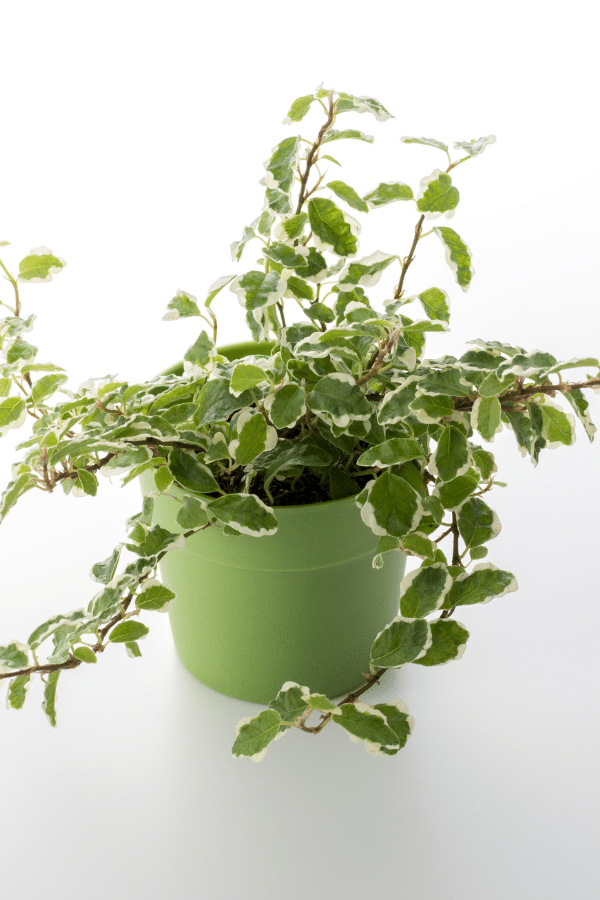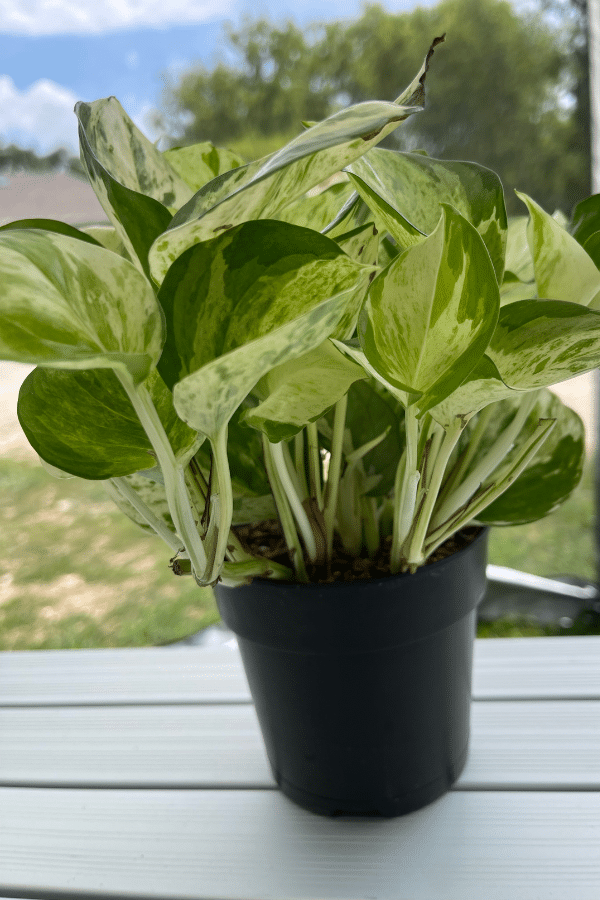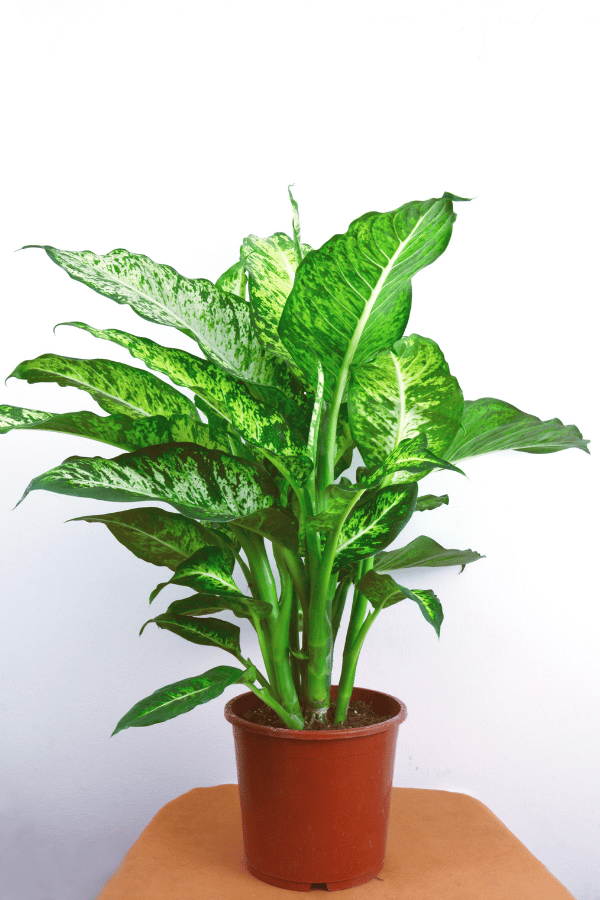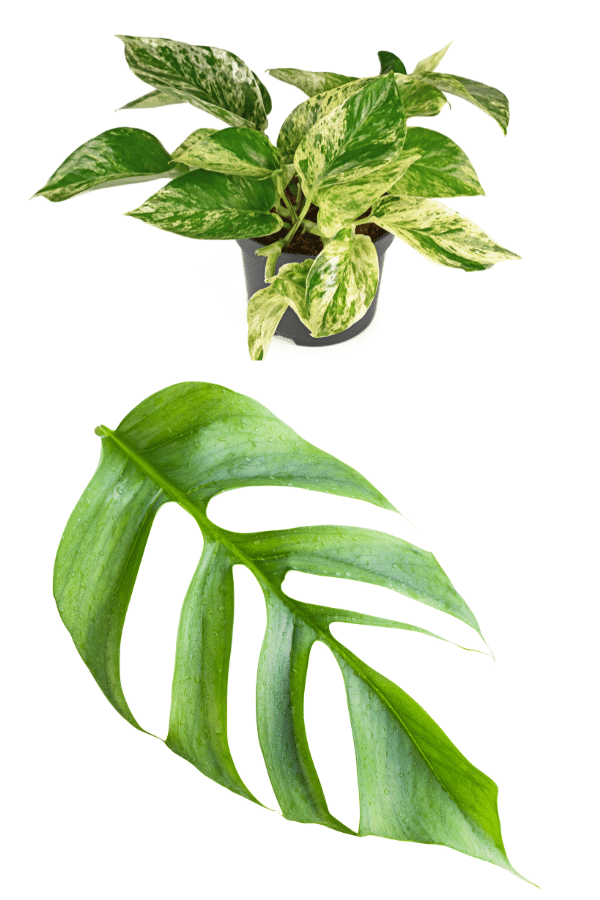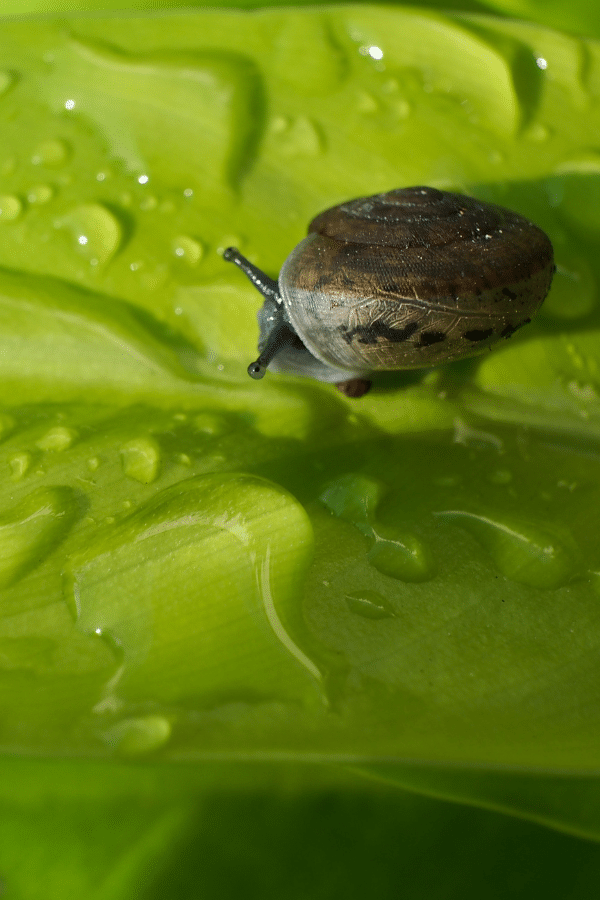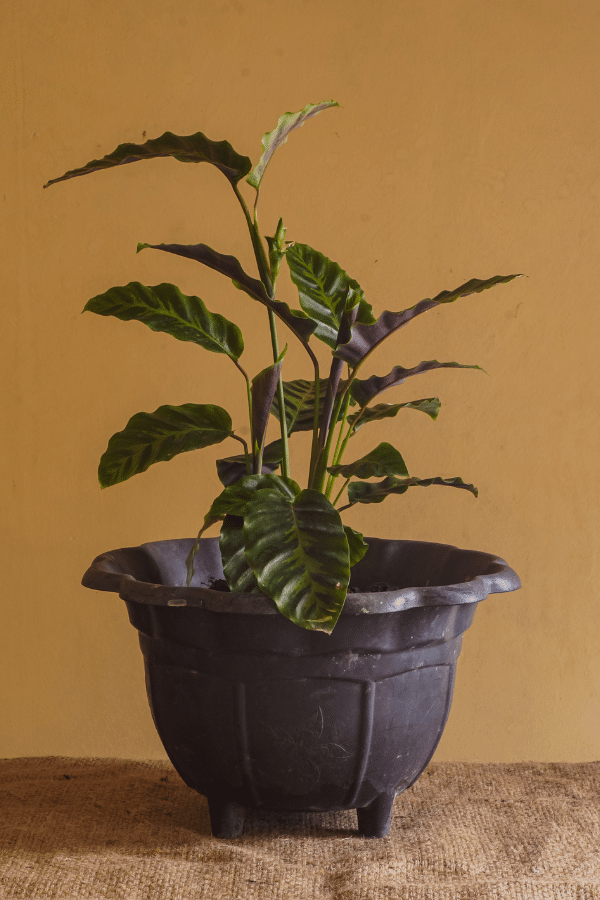Calathea Ornata
Scientific Name: Calathea Ornata
Common Name: Pinstripe Calathea
Calathea Ornata care requires more attention than a “set it and forget it” houseplant. Pinstripe Calathea is good for people with some houseplant experience and not a great plant for beginners.
To give this Calathea plant the best care, it requires high quality soil, water by balancing dryness and moisture, give it bright indirect sunlight, and humid environments ranging in temperature from 65-85F.
Quick Care Overview
| Common Name | Pinstripe Calathea |
| Scientific Name | Calathea Ornata |
| Family | Marantaceae |
| Origin | South America |
| Growth Rate | Medium |
| Identification | Glossy, dark green leaves with feathered pink veining |
| Height | Up to 3 feet tall |
| Soil | Peat soil with addition of perlite |
| Water | Keep soil moist but not over-saturated |
| Temperature | 65-85F |
| Sunlight | Bright indirect sunlight |
| Toxic to Cats & Dogs | No |
| Toxic to Humans | No |
| Pests | Aphids, mealybugs, spider mites, fungus gnats |
| Diseases | Root rot |
Below we will dive deep into this Calathea Ornata care guide.
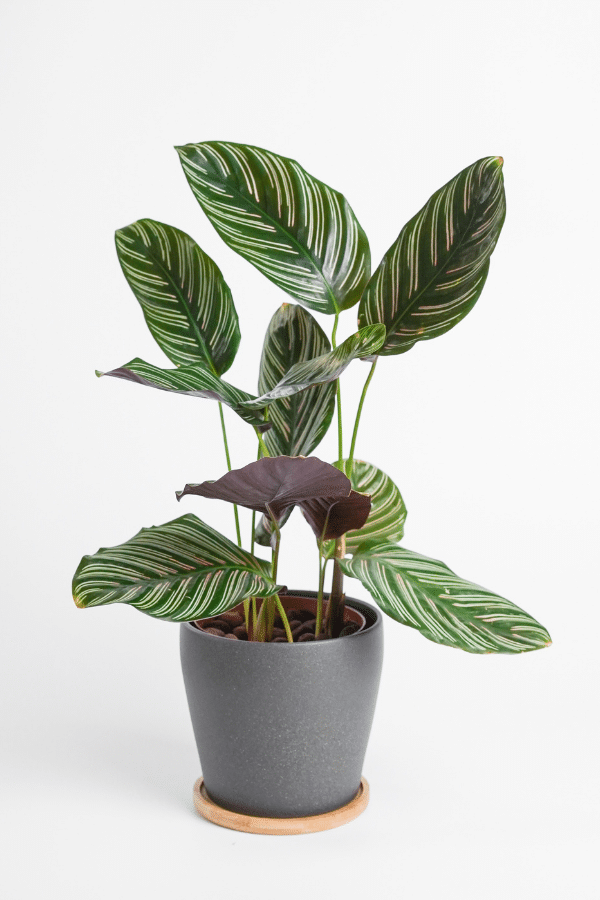
Pinstripe Calathea Ornata History
South American native Calathea Ornata, otherwise known as the Pinstripe Calathea, is a tropical plant that can bring vibrant tropical life to the home. Known for its large, patterned leaves with stunning colors, this Calathea is an excellent choice to bring contrast to your interior design. Known as a somewhat challenging plant, this plant is not known to be a great pick for beginners. However, if you can give this plant the care it needs, you will be rewarded with brilliant, lively foliage.
Pinstripe Calathea Ornata Identification
Presenting with dark green, glossy leaves, this Calathea has feathered-looking veins with a pink hue. The undersides of the leaves have a gorgeous reddish-purple color. Pink stripes will turn white as the plant ages.
Pinstripe Calathea Ornata Growth Facts
When being grown under cultivation indoors, unlike its full maturity height outdoors when found in its natural habitat, this Calathea plant will stay relatively compact and will rarely grow bigger than 3’.
How Big Does a Pinstripe Calathea Ornata Get?
Pinstripe Calathea can grow up to 3 feet tall and 3 feet wide.
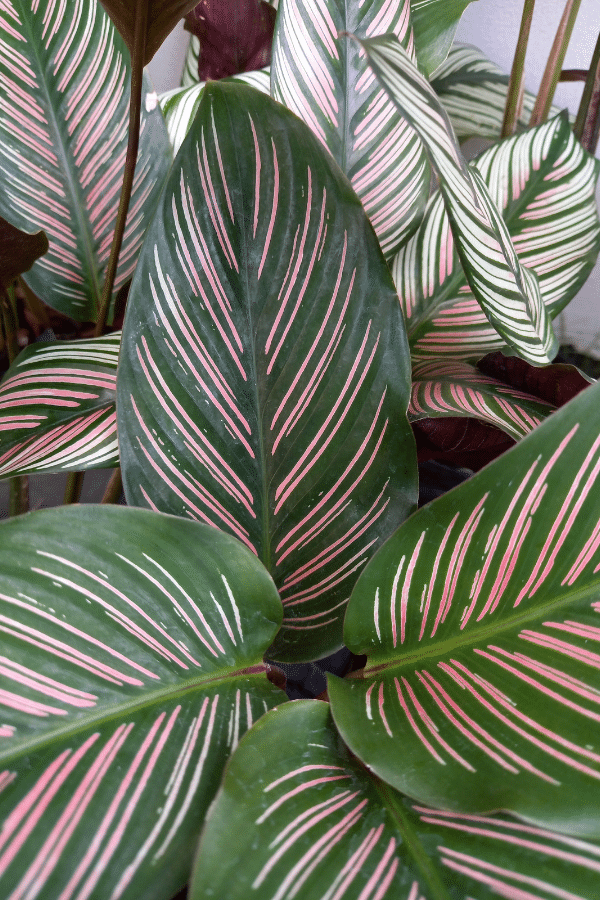
Pinstripe Calathea Ornata Care
Coming from the family Marantaceae, this plant can be a bit tricky to care for, but with some determination, you will find the right balance of elements this plant needs to thrive.
Pinstripe Calathea Ornata Soil
Like many other tropical plants, Calathea Ornata likes to have moist soil but not waterlogged. Therefore, it is necessary when potting this plant to find a growing medium that won’t drain too slowly, as this will lead to root rot. However, the soil must also retain some water, as soil that dries too quickly will lead to browning. A coco-coir-based or peat-based soil with additions of standard high-quality potting soil and perlite will be an excellent mixture for the best Calathea Ornata care. Alternatively, you may consider a standard commercial African Violet soil.
Pinstripe Calathea Ornata Fertilizer
Although not considered a heavy feeder, this Calathea indoor plant will appreciate a regular monthly feeding during the growing season of spring and summer. A stand tropical liquid houseplant fertilizer diluted to half strength and with plenty of micronutrients will be perfect for your Calathea. Avoid fertilizing your plant in the winter or overfertilizing. This may lead to issues such as root burn from excess chemicals. Instead, begin your fertilizer regimen when you see new growth in early to mid-spring.
Pinstripe Calathea Ornata Watering
The watering demands of Calathea Ornata can be challenging to perfect, as it likes to balance dryness and moisture. Overwatering and underwatering will both distress this plant and cause unsightly foliage. Also, ensure that excess water is not sitting within the plant’s tray, which may lead to root rot. It may take some time to find the perfect watering schedule that works for your Calathea, and it will vary widely depending on growing conditions. When watering, use distilled water or rain water to avoid giving the plant excess chemicals from tap, hard water.
Pinstripe Calathea Ornata Light Requirements
This Calathea likes to be grown in bright indirect light, such as from a western or southern-facing window. Ensure that your plant is not sitting in direct sunlight, as this may cause leaf scorching or make the foliage fade. A little bit of shade from sitting next to a window with a sheer curtain will also make this houseplant happy.
Pinstripe Calathea Ornata Temperature & Humidity
Pinstripe plants love warm, humid environments free from winds or drafts. These plants detest cold temperatures and should not be kept lower than 60F as this may cause irreparable damage. Being kept at average household temperatures between 65-85F is ideal. Additionally, this plant loves to be kept in high humidity. This Calathea should be kept between humidity levels of 50-60%. You may increase the humidity in your home by either grouping plants together, placing them on a pebble tray, adding a humidifier, or mist the plant daily.
Repotting Pinstripe Calathea Ornata
When it comes to this Calathea, they do not want to be repotted unless necessary. This is because they will experience a great deal of shock when being repotted. However, if your plant has become extremely rootbound or there is no room whatsoever for your plant to grow, you should replant your plant in early spring. It would be best if you never repotted an unhealthy Calathea. It will need all of its strength to recover from the shock of being transplanted. Select a container that is 1-2″ larger than the container you have now with drainage holes and choose a well-draining potting mix, such as mentioned above. When repotting, be cautious to not disturb the roots, water thoroughly, and place in indirect light. At first, the foliage of your Calathea may wilt some, but after a few weeks, it should bounce back.
Pinstripe Calathea Ornata Maintenance & Pruning
To give the best Calathea Ornata care, you will need to prune this plant. The foliage of the Pinstripe Calathea may occasionally turn brown, yellow, or dry up; if this happens periodically, it is no cause for concern. As needed, you may prune away dead or dying leaves to spruce up the appearance of your plant occasionally. Additionally, suppose the tips of the leaves have become brown due to too much sunlight, underwatering, or overfertilization. In that case, you may trim away only the crispy leaf edges that are browned, following the natural curve of the leaf. Keep this plant away from vents and cold drafts from windows.
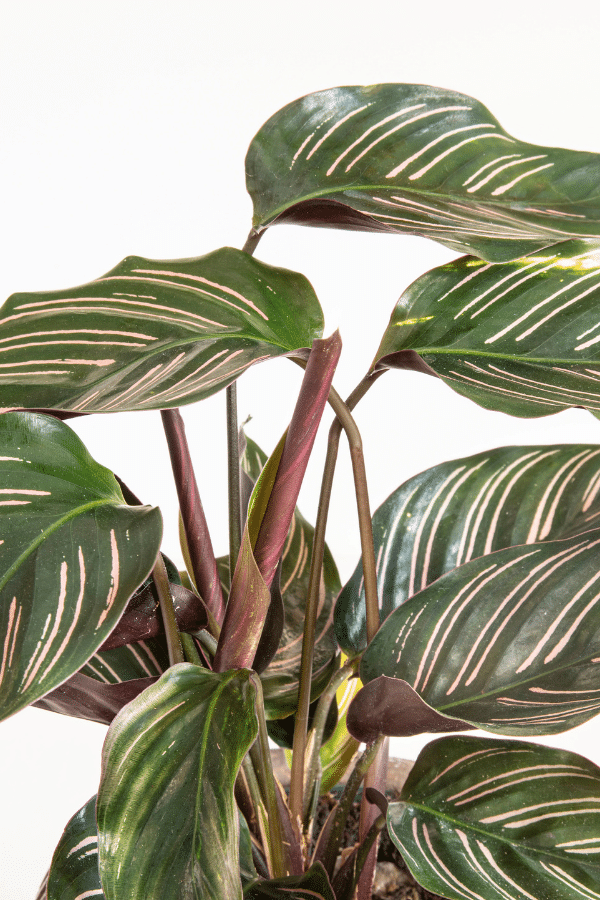
Pinstripe Calathea Ornata Propagation
Propagation of Calathea Ornata is straightforward and may be done through either root division, stem cutting, or from seed. Propagation should be done in early spring before the rapid growth of summer begins. When new clumps are seen growing at the sides of the plant, it is a good indication that your Calathea is ready to be divided. First, remove the mother plant from its container with care, being careful to not disturb the roots that much. Next, use a sharp, clean blade to cut off clumps growing to the side of the plant. The sections that you divide should ideally each have one leaf at a minimum and some roots; otherwise, it might not take to being transplanted. Each new segment should be repotted into its container, watered lightly, and kept in indirect light. You should see the freshly potted plants recovered and beginning to grow again within a few weeks.
Pinstripe Calathea Ornata Toxicity
Calathea Ornata is non-toxic to humans and pets.
Toxicity to Humans
The Pinstripe Calathea is considered non-toxic to humans. However, consuming this plant may cause digestive upset.
Toxicity to Cats & Dogs
This prayer plant is safe for pets and is a wonderful choice for worried pet owners.
Pinstripe Calathea Ornata Problems
Pinstripe Calathea Ornata Leaves Turning Yellow
The foliage of Calathea Ornata may turn brown due to various factors such as chemical-laden water, overfertilization, underwatering, or too much direct sunlight. In addition, this plant is sensitive to chlorine and fluoride in tap water. Therefore, distilled water or rainwater should be used.
Pinstripe Calathea Ornata Leaves Turning Brown
If leaves are fading or turning yellow (often called chlorosis), this may be due to too much sunlight or overwatering.
Pinstripe Calathea Ornata Diseases
The most commonly found disease in Calathea Ornata is root rot due to overwatering.
Pinstripe Calathea Ornata Pests
Several pests may affect this plant including aphids, mealybugs, spider mites, and fungus gnats. Upon identification, treat with a pesticide ensuring that you follow all label instructions.
FAQ
Where Should I Place My Calathea?
Calatheas like bright indirect sunlight and only grow to be about 3 feet tall, so placing the Calathea on a plant stand next to a window with sheer curtains is ideal.
Why Is My Calathea Ornata Curling?
Calathea Ornata curl their leaves because of water loss, such as too little water, too little humidity, and when the temperature is too high. Provide them with plenty of humidity and a good watering schedule to avoid this.

